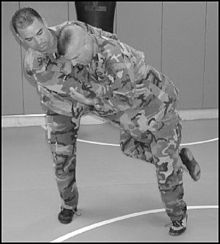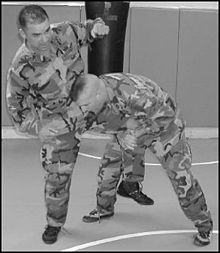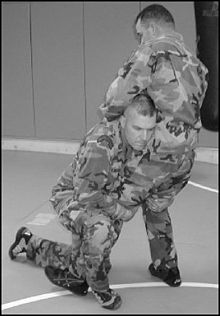- Takedown (grappling)
-
Takedown Usage of a leg trip to perform a takedown. Parent style Wrestling, Judo A takedown is a martial arts and combat sports term for a technique that involves off-balancing an opponent and bringing him or her to the ground, typically with the combatant performing the takedown landing on top. The process of quickly advancing on an opponent and attempting a takedown is known as shooting for a takedown, or simply shooting. Takedowns are usually distinguished from throws by the forward motion and target of advancement (typically the legs), the terms are used interchangeably for techniques. Takedowns are featured in all forms of wrestling and stand-up grappling.
Contents
Leg trip
Leg trip (depending on type also known as a leg sweep) refers to a technique in which the combatant performing the leg trip uses his or her own leg(s) to off-balance an opponent, hence causing the opponent to fall to the ground. Leg trips are often integrated into more complex takedown techniques, and are also important in many throws. Takedown techniques that are pure leg trips usually involve controlling the body of the opponent, and impeding or destabilizing one or both of the opponents legs. Leg trips are featured in for instance Freestyle wrestling, Judo, Sumo, and Shuai Jiao while being an illegal technique in Greco-Roman wrestling.[1]
The scissor kick takes down an opponent by wrapping one's legs around the opponent.
Single leg takedown
The single leg takedown (often shortened to single leg or single) involves grabbing one of the legs of the opponent, usually with both hands, and using the position to force the opponent to the ground. Typically, the lower part of the leg is pulled in one direction, while the torso or shoulder is used to press the body or upper part of the leg of the opponent in the other direction. There are several varieties of single leg takedowns. Some hold the leg by the ankle and are often known as ankle picks, while other varieties include high crotch, which hold the leg high up in the crotch area. Single leg takedowns can also be executed in combination with a leg trip to the other leg, which additionally destabilizes the opponent. Single leg takedowns can be countered by sprawling, and, where allowed, in combination with knee strikes to the head of the opponent.[2]
In Judo and other martial arts, there are many classifications of different types of single leg takedowns. Variants of the high crotch correspond to sukui nage (掬投, "scoop throw"[3]), where the opponent is lifted up from the ground,[4] while the typical forward pushing single leg takedown is classified as morote gari[5] (双手刈, "both hands scoop"[3]) (similarly to certain double leg takedowns). Some techniques are more specific, for instance kibisu gaeshi (踵返, "heel trip reversal"[3]), which is an ankle pick where the heel is grabbed, scooped up and the opponent is pushed and thrown immediately. In kuchiki taoshi (朽木落, "one hand drop"[6]), the opponent's leg is grabbed, pulled up, and used to push the opponent down to the ground in a split second.[7] The technique was banned in judo competition by the International Judo Federation in 2010 except as a counter or combination.[8]
Double leg Takedown
The double leg takedown (colloquially simply known as a double leg or even double) involves grabbing the opponent with both arms around the opponent's legs while keeping the chest close to the opponent, and using this position to force the opponent to the ground. There are several varieties of forcing the opponent to the ground, such as lifting and slamming, or pushing forward with the shoulder while pulling the opponent's legs. The double leg takedown can be countered similarly to a single leg takedown, by sprawling, moving away, and/or striking. The Guillotine choke is also a good counter to a poorly performed double leg takedown.[9]
The double leg takedown is in Judo also referred to as morote-gari,[5] although some hold that a double leg takedown where the opponent is lifted into the air or swept sideways should be referred to as sukui-nage.[5] Morote-gari, despite having been used by judokas for a very long time and being approved of by Jigoro Kano himself, was not accepted until 1982 by the Kodokan[5] as an official Judo technique. Being dismissed by certain traditionalists,[10] the technique was banned in competition by the International Judo Federation in 2010 except as a counter or combination.[11]
Another form of a double leg takedown is the double leg and trip. In which the person shoots in and while holding both legs swings the other leg around and pushes forward on the opponent while tripping the opponents leg out from under him.
See also
References
- ^ Gabrielson, Bruce. Freestyle Wrestling Rules. www.blackmagic.com. URL last accessed March 6, 2006.
- ^ Løvstad, Jakob. The Mixed Martial Arts Primer. www.idi.ntnu.no. URL last accessed March 6, 2006. (DOC format)
- ^ a b c Ohlenkamp, Neil. The 67 Throws of Kodokan Judo. judoinfo.com. URL last accessed March 6, 2006.
- ^ Kodokan Judo Institute. 5. Sukui-nage (hand technique). www.kodokan.org. URL last accessed March 6, 2006.
- ^ a b c d Kodokan Judo Institute. 7. Morote-gari (hand technique). www.kodokan.org. URL last accessed March 6, 2006.
- ^ International Martial Arts Federation USA. An Outline of Kodokan Judo. www.imafusa.com. URL last accessed March 6, 2006.
- ^ Kodokan Judo Institute. 13. Kibisu-gaeshi (hand technique), further reading: 12. Kuchiki-taoshi (hand technique). www.kodokan.org. URL last accessed March 6, 2006.
- ^ Intojudo.eu. New rules 2010-2012
- ^ Green, Andrew The Double-Leg Take Down. www.budoseek.net. URL last accessed March 6, 2006.
- ^ Lewis, Bill. Bill Lewis Review: Pickups. www.bjj.org. URL last accessed March 6, 2006.
- ^ New rules 2010-2012
External links
- Crotch throw
- Double Leg Shoot vs. Right Cross
- Double-leg takedown. Video clip of a double leg takedown. (MPG format)
- Kibisu Gaeshi (Heel Trip Reversal)
- Kimarite. List of Sumo takedowns.
- Sukui-nage (Scoop Throw)
- Wrestling takedowns
- Double Leg Takedowns 101
- [1]
- Self-Defense Takedowns against a wall. Video Clip(s) and article
Grappling Grappling Based Martial Arts Aikido · Brazilian Jiu-Jitsu · Catch Wrestling · Chin Na · Glima · Judo · Jujutsu · Kinomichi · Kurash · Luta Livre Esportiva · Malla-yuddha · Mongolian wrestling · Pahlavani · Pehlwani · Sambo · Shoot wrestling · Shuai Jiao · Ssireum · Sumo · Wrestling · Yağlı Güreş · JujutsuGeneral Techniques Bridge · Collar tie · Eye-gouging · Fish-hooking · Holds · Hooks · Ippon Seoinage · Muay Thai clinch · Nelson hold · Overhook · Small joint manipulation · Stacking · Sprawl · Sweep · Takedown · Transition · UnderhookGrappling positions Back mount · Clinch fighting · Collar-and-elbow position · Cradle · Crucifix position · Guard · Half guard · Harness · Knee-on-stomach · Mount · North-south position · Over-under position · Pinch grip tie · Side controlSubmission types Organisations ADCC Submission Wrestling World Championship · Mundials · International Federation of Associated Wrestling Styles · North American Grappling Association · Grapplers Quest
Wikimedia Foundation. 2010.



